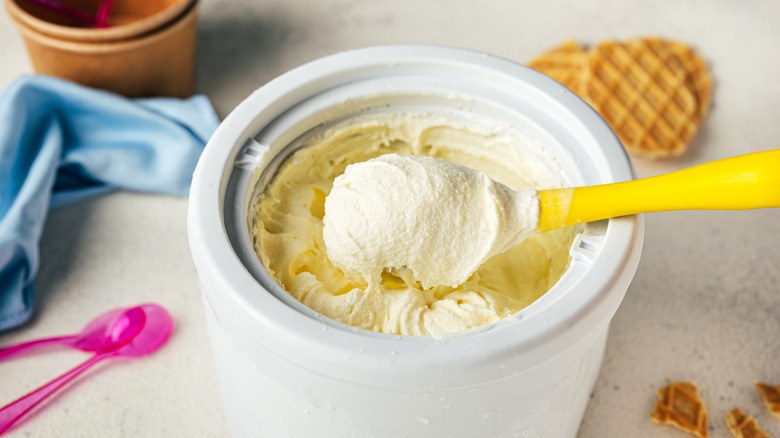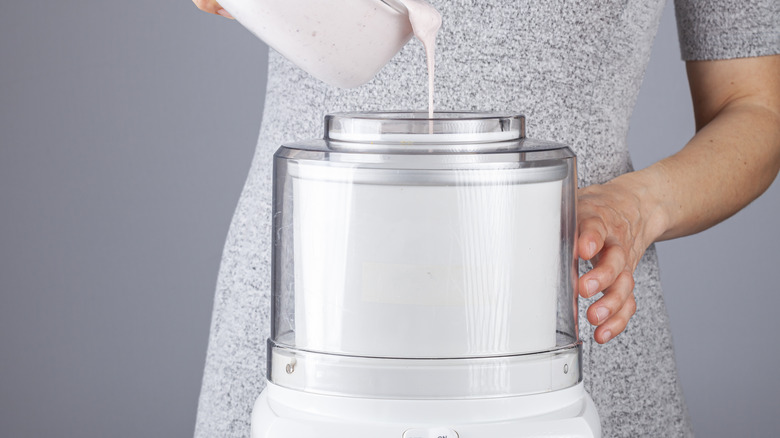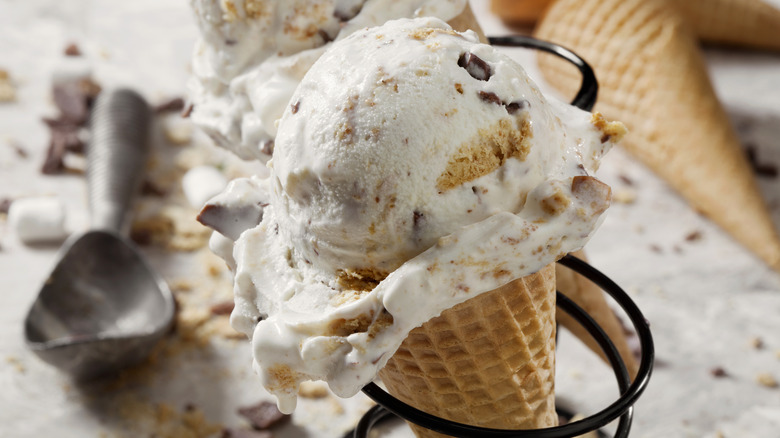The Easiest Way To Clean Your Ice Cream Maker
Ice cream makers are designed to make cooks' lives easier. All you have to do is pour your liquid base into the frozen mixer, and the machine will do the rest of the work. The challenge comes after your fresh pints are tucked in the freezer, and you're left with a chilly bowl with ice cream stuck to the sides.
Instead of wrestling with each frozen droplet, go straight to the sink. A blast of warm water along the frozen canister with a little soap will rinse it clean. You may have been taught not to shock your favorite pan with water after cooking, but here clashing temperatures are not a problem. The same is true for soft serve makers, gelato makers, and compressor ice cream machines.
Your freezer bowl is likely not dishwasher safe, but this approach should eliminate the need for extra cleaning power. Once it's back to sparkling, make sure to dry it thoroughly and then return it to its spot in the freezer. This way, it's chilled and ready for immediate use next time the urge for a cold treat strikes. Don't forget to give the machine itself a quick wipe with a damp towel, as well.
Extra tips when using an ice cream machine
Using an ice cream maker seems pretty straightforward: pour in custard, and wait for it to churn. And while there are a few factors that can stop your ice cream from freezing, like adding too much booze, the process is indeed simple. However, it can also be frustrating, especially if you're expecting a lightning-fast activity. The keys to making the best possible ice cream are patience and planning.
First, think about the bowl itself, which needs to be frozen for at least 15 hours between uses. Plus, you'll want to make sure it stays chilled until the last possible minute when you're ready to pour your liquid base into the canister. Once you're ready to spin, anticipate the process taking about 15 to 20 minutes, and then another hour or two for the finished soft serve to firm up in the freezer.
Of course, shoppers can also seek out a compressor ice cream machine, which will eliminate much of the preparation time. These sophisticated machines chill as they work so you don't have to worry about prepping the canister, but they do come at a significantly higher price tag and take up more counter space. Or, ditch the custard-making process and use instant pudding mix or cornstarch, rather than eggs, to thicken your liquid base. It'll be slightly less rich, but delicious nonetheless.
Use your ice cream maker to its fullest potential
Homemade ice cream gives you the chance to make your favorite flavors, experiment with fresh ingredient combinations, and achieve a miraculously silky texture. In addition to recreating childhood treats, like s'mores or rice crispy treat ice cream, your custard base can also capture the scent of fresh herbs to make mint or basil. Just remember, when tweaking your favorite vanilla ice cream recipe to accommodate your tastes, you'll want to maintain the high sugar level, as freezing the liquid will dull its sweetness.
One of the most fun aspects to consider when churning your ice cream is the mix-ins. Crunchy elements like cookie bits, nuts, cereal, and salty snacks like potato chips all make for a pleasant contrast against your favorite flavor. You'll want to use about one to two cups of your preferred items, and, if possible, get them chilled or frozen before adding them to the ice cream machine in the last few minutes of mixing.
After you've gotten the hang of things, consider taking a more experimental approach with your icy treats. Try raiding your bartending station for unexpected syrups and runny jams, which can imbue your mixture with cocktail-friendly flavors, like Earl Grey tea, juniper, Sichuan pepper, or bitter Aperol. For more funky contrast in texture and aroma, use leftovers from your last dinner party — like candied citrus peels, blue cheese and nuts, or roasted sweet potatoes or corn — to straddle the sweet-savory line.



